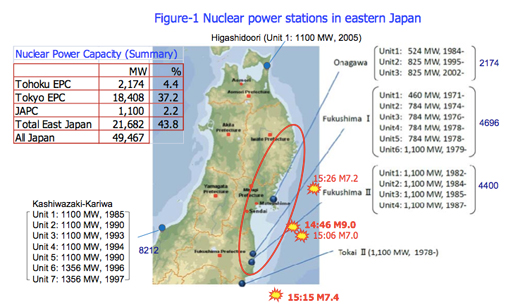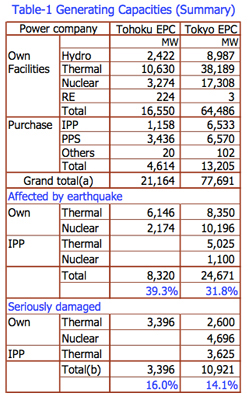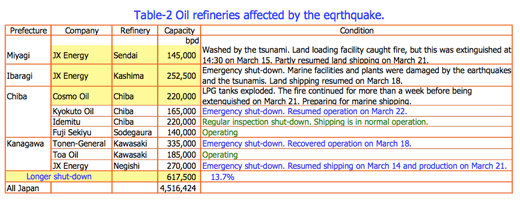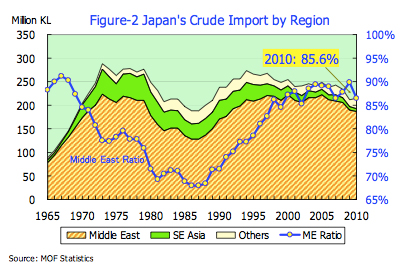A dreadful earthquake (9.0 on the Richter Scale, the highest ever observed in Japan, with a multitude of M7 class aftershocks) arid ensuing tsunamis hit the eastern Japan coastline in the afternoon of March 11, claiming the life of tens of thousands of people and devastating local cities, towns and villages. The tsunamis were extremely powerful and violent, as they were amplified by the saw-tooth coastline, a particular topographic feature of the area, rendering useless even the gigantic breakwater built after the lessons from the 1960 Chilean tsunami. The Tokyo Metropolitan area, approximately 300km away from Sendai, was temporarily paralyzed due to the complete stoppage of public transport, but was saved from major devastation.
Among energy facilities, nuclear power stations in the area were immediately shut down, but some of them not completely successfully. Two oil refineries, one in Sendai and the other in Chiba, caught fire and were disabled. The earthquake and tsunamis have caused serious disruptions to electricity and fuel supply in the wide expanse of eastern Japan, further exacerbated by the concerns over radioactive contamination from the wrecked nuclear plant. The post-disaster disturbance is likely to last quite a while longer before Japan can begin full-fledged restoration.
In the following sections of this issue, Japan Energy Brief (JEB) will attempt to present the readers with a comprehensive picture on energy situations in the area as they are available as of this writing, and to analyse their impact and potential implications for Japan's energy policies in the future.
Energy supply situations
Electricity
Immediately after the earthquake, some 4.9 million electricity users in the Tohoku (northeastern) regions and several thousands in the Tokyo regions lost power supply. By March 18, however, electricity supply was restored in most of the affected areas except for about 270,000 users in the tsunami-stricken Tohoku regions where local communities were simply wiped out or buried under piles of debris. To cope with anticipated power shortages and to avoid a widespread blackout, Tokyo EPC (Electric Power Company) began planned power cuts on a rotational basis. To control electricity consumption, trains were operated with a reduced number of services in the Tokyo and suburban areas. Tohoku EPC has also announced a similar power cut program but has not implemented this as yet.
There are five nuclear power plants with a total of 15 reactors and an aggregated generating capacity of 13.5 GW in the region (see Figure-1). At the time of the earthquake, four of them were off-line for maintenance and the remaining eleven in operation were immediately shut down. Eight plants were safely brought to cold (i.e. normal) stop conditions, but a serious incident occurred at the Fukushima No.1 nuclear power station.

At first, the emergency procedures at the station were successfully in progress using its emergency power system. However, after one hour from the initial shock, unexpectedly strong tsunamis surged and destroyed the auxiliary power system. The monster tsunamis were more than 14m in height, while the power station was designed against an earthquake of 7.9 and a tsunami with a maximum height of 5.4m. In addition to the Unit Nos. 1, 2 and 3 immediately shut down operation, Unit No. 4 under maintenance kept a substantial amount of used fuel rods in its internal storage that need to be cooled down. Without power supply, these plants (all are of BWR model) were out of control and cooling water began to evaporate to expose the fuel rods above the water level.
Under the extraordinary heat, the zirconium alloy covering the fuel rods produced hydrogen. Plant buildings shrouding the nuclear reactors exploded one after another, most likely from explosions caused by the hydrogen that had somehow seeped into the housing. The buildings were seriously damaged and higher-than-normal levels of radioactive contamination were observed around the plant site. More than 100,000 people in the 20km radius from the site were evacuated and those within 30km were asked to stay inside buildings.
After various and desperate trials to cool down the fuel rods using helicopters and special fire pumps, die Tokyo Municipal Firefighting Team succeeded over the night of March 19-20 to pour more than 1,000t of sea water onto the Unit No. 3. Emergency power lines for the units were connected on March 22. These reactors are considered to have narrowly averted a criticality incident as of March 24. After they have been brought under control, then equally serious and difficult challenges need to be addressed concerning how to demolish these contaminated plants.

At the initial shock of the earthquake, thermal power plants with an aggregated generation capacity amounting to 14.5GW in Tohoku and Tokyo area were also immediately shut down.
Together with the nuclear power plants, Tohoku EPC lost 39 percent of the generating capacity and Tokyo EPC 32 percent (see Table 1). While many of these units resumed operations in a relatively short time, both Tohoku and Tokyo EPCs lost about 15 percent of their respective generating capacities for a longer duration. Seriously-damaged power plants include Sendai #4 (446MW, Gas), New-Sendai #1 (350MW, Oil and Gas), #2 (600MW, Gas), Haranomachi #1 and #2 (both 1.000MW, Coal) of Tohoku EPC and Hirono #2 (600MW, Oil), #4 (1,000MW, Oil) and Hitachinaka #1 (1,000MW, Coal) of Tokyo EPC. Detailed status of IPPs at this point had yet to be assessed.
Electricity shortage will be mitigated gradually as power stations presently under maintenance service are brought back on line one by one. However, a power shortage is definitely anticipated for the summer cooling demand season as well as next winter, according to Tokyo EPC.
Oil
Six oil refineries in the region were affected by the earthquake and tsunamis. Among them three were seriously damaged, while the other three resumed operation shortly after. The Sendai refinery of JX Nippon Oil and Energy was directly hit by the tsunami and seriously damaged. JX Energy's Kashima refinery was also damaged; its marine facilities and refining plants are considered to require some time for repair. At the Chiba refinery of Cosmo Oil, LPG tanks caught fire after the earthquake, giving rise to a gas leakage. Because of the earthquake, 30 percent of Japan's active refining facilities were immediately shut down, although a half of them resumed operations in a week or so.

As a result, about 14 percent of the 4.5 million barrels per day (BPD) of the Japanese refining capacity need to be repaired over a longer time (see Table 2). Facing this grave situation, METI invoked reduction of the mandatory oil stockpiling level on private companies from 70 days to 67 days equivalent of average consumption on March 14 and further reduced it to 45 days on March 21, enabling oil suppliers to draw down their inventories for emergency relief. As the Japanese oil demand is running slightly below four million BPD this year and some refineries have room to physically increase the nameplate refining capacity, a 15 percent loss of the refining capacity would not cause a serious shortage of petroleum supply as a whole.
Nevertheless, since the Sendai Refinery of JX Energy was the only major refinery operating in the Tohoku district, and many oil terminals facing the Pacific Ocean were damaged by the tsunamis, product delivery to the disaster area has been seriously hindered. Self Defense Force soldiers worked hard to clear a tremendous amount of debris off the roads connecting the seacoast towns destroyed by tsunamis. Idemitsu Kosan reopened its Shiogama terminal on March 21 substantially improving the logistics in the Sendai area. Oil products delivery to the disaster areas began to resume gradually a week after the dreadful Friday.
City gas
According to the Japan Gas Association, 460,000 gas users lost city gas supply due to the earthquake and tsunamis, and the situation had not improved even after a week. The Sendai LNG receiving and regasification terminal, located next to the JX Energy's Sendai refinery, was seriously hit by the earthquake and a 10m-high tsunami. The LNG tank was safe, but regasification plant, piping and fittings were damaged; it may take more than one month to repair. At the point of publishing, the City Gas Bureau said it planned to resume gas supply by connecting its systems to the Niigata-Sendai gas pipeline operated by Japex; gas will be received from the Niigata LNG terminal some 260km away from Sendai.
Recovery operation of the delivery network started on March 16 with supporting teams of gas companies from other regions, but it will take more than three weeks to complete the house by house, check-and-restart operations for 390,000 users in Sendai city alone, excluding the areas that were totally destroyed by the tsunami. Status of users in the tsunami washed towns has yet to be assessed.
Petrochemicals
Almost a quarter of the Japanese ethylene production capacity totalling 1.8 million tons per year (TPA) was stopped by the earthquake. Among them, Kawasaki plant (440,000TPA) of JX Oil and Energy was not hurt and is preparing for restart-up within March. However, damages at the Kashima plant (No. 1 and No.2 units totalling 820,000TPA) of Mitsubishi Chemical are significant at marine and other offsite facilities. It is anticipated to take more than two months to resume operation according to the company. The alcohol-ketone plant of the Chiba plant of Maruzen Petrochemical (525,000TPA) caught fire from the earthquake, and this was soon extinguished. However, whole plants were shut down and their recovery is considered to take time.
Medium/long-term issues to be addressed
Needless to say, the immediate and urgent challenges for Japan are to rescue the victims of earthquakes and tsunamis, as well as to control and safely dismantle the ill-fated nuclear power plants. Hundreds of thousands of people are reported to have been evacuated from their home towns, many of them have lost family members and relatives, houses and working places. Many towns are completely destroyed and many others have lost important social infrastructure such as power and energy supplies, communication systems, railways, roads, water/sewage services, schools, hospitals, and too many more to list. The restoration work will need a huge amount of funding and a longer time. Setting aside the comprehensive restoration plans, the natural disaster has revealed several serious issues in the field of energy, which Japan will have to closely review. They are:
- Security of electricity supply
- Safety of nuclear power plants
- Policies to counter global warming, which has assigned nuclear the central role
In its history, energy security issue in Japan has been discussed mainly in terms of security of energy import but not of the domestic supply system or its reliability. However, the earthquake has revealed an Achilles' heel in the Japanese electricity supply system. This issue was discussed in the wake of the Chuetsu earthquake in 2007 that stopped all seven nuclear units at the Kashiwazaki-Kariwa power station in Niigata Prefecture facing the Japan Sea, and instantly slashed 8.2GW or 10.6 percent of Tokyo EPCs power supply capacity.
However, as these units were restored one after another, the incident gradually faded in people's minds. To compound the matter further, the Japanese power grid is divided into two zones of differing electricity supply due to a difference in frequency inherited from the historical electricity development, i.e. 50Hz for eastern Japan and 60Hz for western Japan. The existing relief connection system can accommodate up to only 1,000MW, or equivalent to less than 2 percent of the electricity demand on both sides of the border, a meager help compared with the 15 percent loss sustained this time by Tohoku and Tokyo EPCs to a more permanent extent. Like oil stockpiling, electricity supply security must be reinforced significantly.
Some of the candidate solutions may include: 1) To unify the power frequency system nationwide; 2) to construct convertible power stations with a flexible frequency control system along the frequency border; 3) to develop substantial capacities of distributed power sources, and so on. Among them, unification of frequency appears to be most effective, but in reality almost impossible to implement as it requires inordinate efforts to change an astronomical number of electric appliances on either side of Japan. An increase in the distributed power supply source will mitigate dependence on the grid power supply but would not solve the problem to an effective extent. Convertible power stations may be the most realistic answer although this also will require a huge amount of investment.
The magnitude of the earthquake experienced this time was so gigantic that it is said to occur once in thousand years. Nevertheless, after we have encountered what we could not conceive the real world, no one can say for sure that it would not come again tomorrow. We need to establish a much more reliable fail safe system. We should also develop simple and clear-cut technology principles which everybody could understand. By not doing so, it may take not years but decades for people to regain their confidence in technology. In the above context, the Basic Energy Plan of Japan assigning to nuclear power a central role of shouldering 40-50 percent or more of electricity will have to be revisited. It would not be very difficult for Japan to supplement the 4.7GW generation capacity lost at the Fukushima No. 1 plant since, for example, construction of one or two LNG power plants will suffice. However, construction of additional nuclear* capacity under the Basic Plan is most likely to encounter extreme difficulty given the bankruptcy of the so-called "Safety Myth" and the people's confidence in technology going down the drain.
On the other hand, Japan has been watching with bated breath the recent upsurge of democratic movements in the Middle East and North Africa, not only the immediate outcome of the fighting in Libya. Japan imported 86.5 percent of crude oil and 22.5 percent of LNG from the Middle East in 2010. Oil held 45.8 percent and natural gas 17.5 percent of its primary energy supply in 2009.

In summary
Japan depends on 44 percent of the primary energy supply on the Middle East. While the Basic Energy Plan stipulates reduction of fossil fuel dependence, oil ought to supply 30 percent and LNG 16 percent of the primary energy in 2030, even when nuclear and renewable energies are developed in line with the ambitious plan. Increasing Russian crude import from new Pacific coast ports has decreased Japan's dependence on the Middle East by 4 percent from 89.5 percent in 2009 to 85.6 percent in 2010. The Russian share may increase another 5 percent or so when the trans-Siberian pipeline fully completes in 2012. Nevertheless, the Middle East will remain the primary energy suppliers for Japan for the foreseeable future. With more than 170 days of oil in stockpile, Japan is anxiously watching the evolution of the democratic movements giving a substantial impact on its energy security.
As discussed above, one of the core policies of the Basic Energy Plan is in danger of infeasibility, and hence the environmental policy to fulfill Japan's pledge in its measures to counter global warming. The emission reduction target and policies set out by the DPT Administration in 2009 were already under severe criticism. In formulating the rehabilitation plan, energy security and environmental policies ought to be totally overhauled so that Japan could make this tragedy a cornerstone to build a safe and green society, through a solid pathway supported by practicable and reliable measures, realising great breakthroughs in technology and socio-economic system.
Article reproduced with permission from The Institute of Energy Economics' Japan Energy Brief, which delivers energy and environment news in Asia and Japan, well as its comments, analysis and opinions.
By : IEEJ Japan Energy Brief